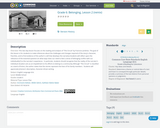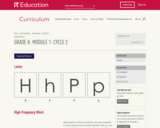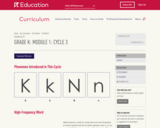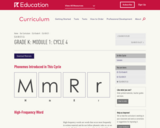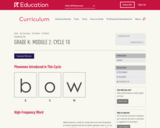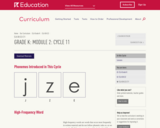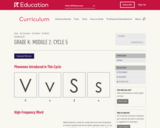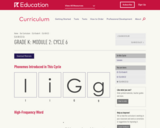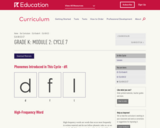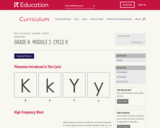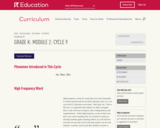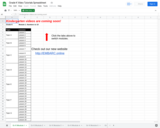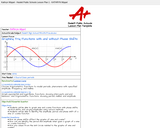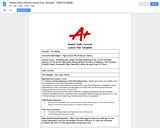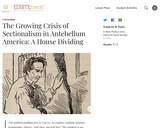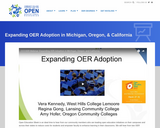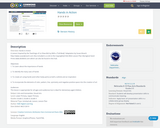ELA GK:S1:C3
GRADE K: MODULE 1: CYCLE 3
ELA GK:S1:C2:L15
ELA GK:S1:C3:L16
In this Cycle
Lessons
You are here:
ELA Grade K
ELA GK:S1
ELA GK:S1:C3
Like what you see?
Order printed materials, teacher guides and more.
How to order
Help us improve!
Tell us how the curriculum is working in your classroom and send us corrections or suggestions for improving it.
Leave feedback
Download Materials
Phonemes Introduced in This Cycle
K
K
k
k
N
N
n
n
High-Frequency Word
the
High-frequency words are words that occur most frequently in written material and do not follow phonetic rules or, as we say in the EL Education curriculum, "don't play fair." Due to this fact, it is important that students are able to navigate these words with ease to improve their reading fluency and comprehension. While high-frequency words on their own don't carry much meaning, they are essential to sentences and help students gather meaning. Below you will find five activities for each day of the week that teachers can do with students or parents can do with their children at home as high-frequency words are being introduced cycle by cycle.
Read it, say it, write it, read it again
Use high-frequency words in sentences (oral and written)
Read a list of high-frequency words and time yourself on fluency (keep running list)
Search for high-frequency words in sentences/poems and underline them
Fishing for high-frequency words (one person reads the word aloud, other students find the word in a stack of other high-frequency words)
Instructional Practices
The instructional practices listed below summarize the instruction that accompanies the skills that are being taught in this cycle for the respective grade level. Teachers should review these routines for guidance on how to teach the skills and patterns reflected in the microphase.
Lesson 16
Poem Launch: Students hear/read a poem that includes keywords for each letter introduced in the cycle. The verses incorporate new high-frequency word(s) and words that feature the cycle's new graphemes (letters) and phonemes (sounds). This poem is used throughout the cycle for different purposes.
Getting to Know the Letters (Part 1): Students "meet" each new letter for the cycle, exploring the following about each: its name (grapheme), its sound(s) (phoneme), and a consistent keyword that represents the letter. This practice includes a Letter-Sound chant component (see Opening Instructional Practices for more details), using only the newly introduced letters.
Lesson 17
Poem Letter Search: Students explore the already introduced cycle poem for a new purpose: to search for specific letters.
Getting to Know the Letters (Part 2): Students use the same letters as in Part 1, but now get to know the shape and formation of each, practicing first with their bodies and then on paper.
Lesson 18
Mystery Word (Clues to the Mystery Word and Introducing the Mystery Word): Students explore the already introduced poem for a new purpose: searching for a "mystery" high-frequency word. Students are given clues about the number of letters in the word and then search for words with the same number of letters, encouraging student inquiry. They also listen for a word as the teacher reads the words of the poem, clapping when they hear it. This practice is a vehicle for introducing Kindergarten high-frequency words that students will later see in poems and Decodable Student Readers.
Lesson 19
Feel the Beats: Students explore the already introduced poem for a new purpose: to listen for and identify each syllable (beat) in a spoken word. They count the number of syllables in the spoken word, pronounce each one, and manipulate them by segmenting and blending. (Note: Starting in Module 3, this Work Time instructional practice transitions to a shorter, Opening practice.)
Lesson 20
Rhyme Time: Students explore the already introduced poem for a new purpose: identifying rhyming words. They begin with a game that provides an introduction to the concept of rhyming and then revisit the poem, listening for words that rhyme (have the same ending sound). Rhyming develops this phonemic awareness, teaching students to group words together according to larger sound units. Rhyme Time guides students to analyze sounds in spoken words.
Lessons 17, 19-20
Letter-Sound Chant: Students chant the names of letters and accompanying letter sounds in this ongoing routine (used in multiple lessons throughout a cycle) that reinforces taught graphemes (letter) and phoneme (sound) connections and keywords. This chant connects the keywords and phonemes in students' memories to support quick recall of phonemes for decoding and encoding.
